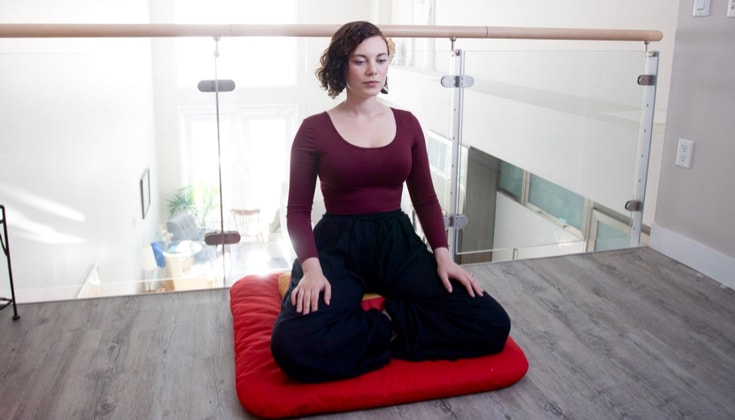Meditation isn't very hard. In fact: if you can breathe, you can meditate. Learn how to meditate, as taught by the Buddha, with our easy-to-follow guide.

Photo by Marvin Moore.
How to Practice Breath Meditation
Breath meditation is likely the most popular and straightforward meditation practice. It is also the basis of many other forms of meditation. Try these essential instructions.
Find a quiet and uplifted place where you can do your meditation practice. When starting out, see if you can allow 5 minutes for the practice.
1. Take your seat. Sit cross-legged on a meditation cushion or on a straight-backed chair with your feet flat on the floor, without leaning against the back of the chair.
2. Find your sitting posture. Place your hands palms-down on your thighs and sit in an upright posture with a straight back—relaxed yet dignified. With your eyes open, let your gaze rest comfortably as you look slightly downward about six feet in front of you.
3. Notice and follow your breath. Place your attention lightly on your out-breath, while remaining aware of your environment. Be with each breath as the air goes out through your mouth and nostrils and dissolves into the space around you.
At the end of each out-breath, simply rest until the next in-breath naturally begins. For a more focused meditation, you can follow both the out-breaths and in-breaths.
4. Note the thoughts and feelings that arise. Whenever you notice that a thought, feeling, or perception has taken your attention away from the breath, just say to yourself, “thinking,” and return to following the breath. No need to judge yourself when this happens; just gently note it and attend to your breath and posture.
5. End your session. After the allotted time, you can consider your meditation practice period over. But there’s no need to give up any sense of calm, mindfulness, or openness you’ve experienced. See if you can consciously allow these to remain present through the rest of your day.
There! You’ve just meditated! For more guidance, follow along with the audio version of this meditation while sitting:
Breath meditation is a vital practice in itself, but it also represents the very foundation of all of Buddhist meditation’s varied forms. We’ll get to some of these shortly. But first: you probably have some questions.
What is Meditation?
Buddhist meditation is the practice of intentionally working with your mind. There are several asian words that translate to “meditation.” These include bhavana—which in Sanskrit means both “meditation” and “to cultivate”—and the Tibetan word gom, which literally means “to become familiar with.” Basic Buddhist meditation starts with practices to help calm and concentrate the mind. From there, you can begin to investigate the nature of reality and develop insight.
The most common form of meditation is breath meditation, in which you rest your attention on your breath, as described in the instruction above. Different Buddhist traditions have slightly different instructions for breath meditation. Vipassana meditation is the form of meditation thought to have been taught by the Buddha himself. Zazen is the stripped-down practice at the core of Zen Buddhism. Mindfulness is the science-backed practice gaining popularity in education, business, and healthcare.
Below, you'll see some different types of sitting meditation. Try a few, and see what feels right for you. Tip: Stick with each meditation for a few sessions to develop a full sense of how it works for you.

How to Practice Shamatha Meditation
Shamatha meditation is the foundation of Buddhist practice. Lama Rod Owens teaches us a version from the Vajrayana tradition.

How to Practice Mindfulness Meditation
This basic mindfulness meditation from Zen teacher James Ishmael Ford offers a great practice to start your day.
Why Meditate?
Everyone meditates for their own reason. The Tibetan Buddhist teacher the 17th Karmapa says meditation awakens a trust that we are full of wisdom and compassion. Meditation can simply calm an excited mind and relax the body. Meditation master Ajahn Chah said,
“As you meditate, your mind will get quieter and quieter, like a still forest pool. Many wonderful and rare animals will come to drink at the pool, but you will be still. This is the happiness of the Buddha.”
On the other hand, meditation fosters a wider awareness and can provoke profound realization. This process can help cut through unhelpful misconceptions and encourage a more open, compassionate relationship with yourself.
Additionally, we might meditate to specifically cultivate certain positive traits. Pema Chödrön lists five key qualities that emerge through meditation practice: steadfastness, clear seeing, courage, attention, and a sense of “no big deal.” Scientists have found that meditation can improve your attention, resilience, compassion, and relationships.
Ultimately, the Buddha taught meditation as an essential tool to achieve liberation from suffering.
To learn more about why we meditate and how it works, you can explore our teachings on the philosophy of meditation:

How to Look at a Wall
Zen teacher Karen Maezen Miller explain's Bodhidharma's famous practice of wall-gazing.

Meditation is the Key to Knowing Yourself
Meditation practice awakens our trust that the wisdom and compassion that we need are already within us.
What Challenges Can Arise in Meditation?
One of the biggest obstacles that can arise in meditation is the misconception that you can be good or bad at it. But, you can’t fail at meditation. The fact is: if you can breathe, you can meditate.
The first question many meditators ask themselves is: how long should I meditate? Most Buddhist teachers will tell you that any time spent meditating is good, no matter how short. The best approach is to figure out what you can manage comfortably, and make it a habit.
You also might find meditation physically uncomfortable. Don’t worry: many meditators, even experienced ones, struggle with discomfort. And then there are practical questions: Where should I put my hands? Should I close my eyes? Am I breathing too much? Here, you can find advice on working with these sorts of questions in meditation:

Why does my breathing feel uncomfortable in meditation?
You can’t breathe wrong. Generally, Buddhist meditation is not a yogic practice in which you’re supposed to breathe in a particular way.

Sleepy Mind, Monkey Mind
Anita Feng shares how to stop going back and forth between drowsiness and "monkey mind."
How Do You Establish a Regular Meditation Practice?
There’s no denying it: meditation is more effective when you do it regularly. One of the biggest challenges for meditators of all experience levels is maintaining a regular practice. When you’re just getting started, it can help to set a dedicated space in your home with a meditation cushion (sometimes called a zafu). We have plenty of advice on starting, maintaining, and building on your meditation practice:

How to Start a Home Meditation Practice
Zen teacher Norman Fischer proposes a two-week trial run to get your meditation practice started and looks at how to deal with some of the obstacles you may encounter.
Are There Other Forms of Meditation in Buddhism?
Yes. The Buddha taught that we should ideally be able to hold the mind of meditation whether standing, sitting, walking, or lying down. Even everyday events like eating an apple or taking a photo on your smartphone can be opportunities to flex our meditation muscles. Various types of meditation are designed to help you cultivate positive qualities.
Some other popular types of meditation are walking, running, metta, and tonglen. Here are some instructions for meditating in many different ways:

How to Invoke the Medicine Buddha
David Michie teaches us a healing meditation to purify karma and cultivate well-being.

Meditating on the Mind Itself
A teaching on the practice of Mahamudra by the late Kagyu master Traleg Kyabgon Rinpoche.
What Does Buddhism Have to Do With Meditation?
Most of the world’s religions involve some form of meditation, but you don’t have to be religious to meditate. Nonetheless, meditation is essential to Buddhism. In the Eightfold Path, the Buddha’s guide to enlightenment, meditation encompasses two of the eight aspects. Meditation alone is not Buddhist. You can find lots more articles on the basics of Buddhism, here:

Frequently Asked Questions about Buddhism
Find short answers to the most common questions about Buddhism.

The Best of the Dalai Lama: Life, Quotes, Teachings, and Books
An introduction to the life and teachings of the Dalai Lama, teacher, educator, science enthusiast, and political leader.

Impermanence is Buddha Nature
Change isn’t just a fact of life we have to accept and work with, says Norman Fischer.
Profound Quotes About Meditation
“The practice of meditation helps us to release the tension—within the body, within the mind, within the emotions—so that healing can take place.”
—Thich Nhat Hanh, “This Is the Buddha’s Love”
—Thich Nhat Hanh, “This Is the Buddha’s Love”
“Meditation practice awakens our trust that the wisdom and compassion that we need are already within us. It helps us to know ourselves: our rough parts and our smooth parts, our passion, aggression, ignorance, and wisdom.”
—Pema Chödrön, “Meditation is the Key to Knowing Yourself”
—Pema Chödrön, “Meditation is the Key to Knowing Yourself”
“It is through vipashyana meditation that we come to realize there is no such thing as an enduring or permanent self and that physical entities have no enduring or permanent essence.”
—Traleg Kyabgon Rinpoche, “Meditating on the Mind Itself”
—Traleg Kyabgon Rinpoche, “Meditating on the Mind Itself”
“Meditation is neither about cultivating nor rejecting, but rather about learning how to be present in the face of whatever arises in our mind.”
—Phakchok Rinpoche and Erric Solomon, “Whatever Arises in Your Mind, Be Present”
—Phakchok Rinpoche and Erric Solomon, “Whatever Arises in Your Mind, Be Present”
“Rest your attention lightly—as lightly as a butterfly rests on a flower.”
—Sharon Salzberg, “The Magic Moment”
—Sharon Salzberg, “The Magic Moment”
“Son, it is not experiences themselves that bind you, but the way you cling to and reject them.”
—Tilopa, quoted in “Are We Really Meditating?”
—Tilopa, quoted in “Are We Really Meditating?”
“The goal is not to become a breathing expert, or even an excellent meditator. The goal is to see clearly the causes and the possible end of mental suffering. It’s to experience, and then want to cultivate, peace of mind for oneself.”
—Sylvia Boorstein, “Daily Life is Practice”
—Sylvia Boorstein, “Daily Life is Practice”
“The Buddha told us to see the way things are and then let go of our clinging to them. Take this feeling of letting go as your refuge.”
—Ajahn Chah, “Advice for Someone Who is Dying”
—Ajahn Chah, “Advice for Someone Who is Dying”
“Don’t prolong the past, don’t invite the future, don’t be deceived by appearances, just dwell in present awareness.”
—Patrul Rinpoche, quoted in “The Place Beyond Fear and Hope”
—Patrul Rinpoche, quoted in “The Place Beyond Fear and Hope”
“If you are busy, then busyness is the meditation. And when you do calculations, know that you are doing calculations. Meditation is always possible, at any time. If you are rushing to the office, then you should be mindful of rushing.”
—Dipa Ma, quoted in “Who Was Dipa Ma?”
—Dipa Ma, quoted in “Who Was Dipa Ma?”












Đăng nhận xét